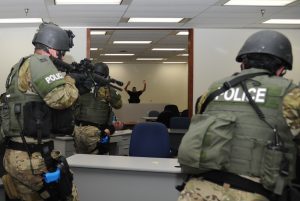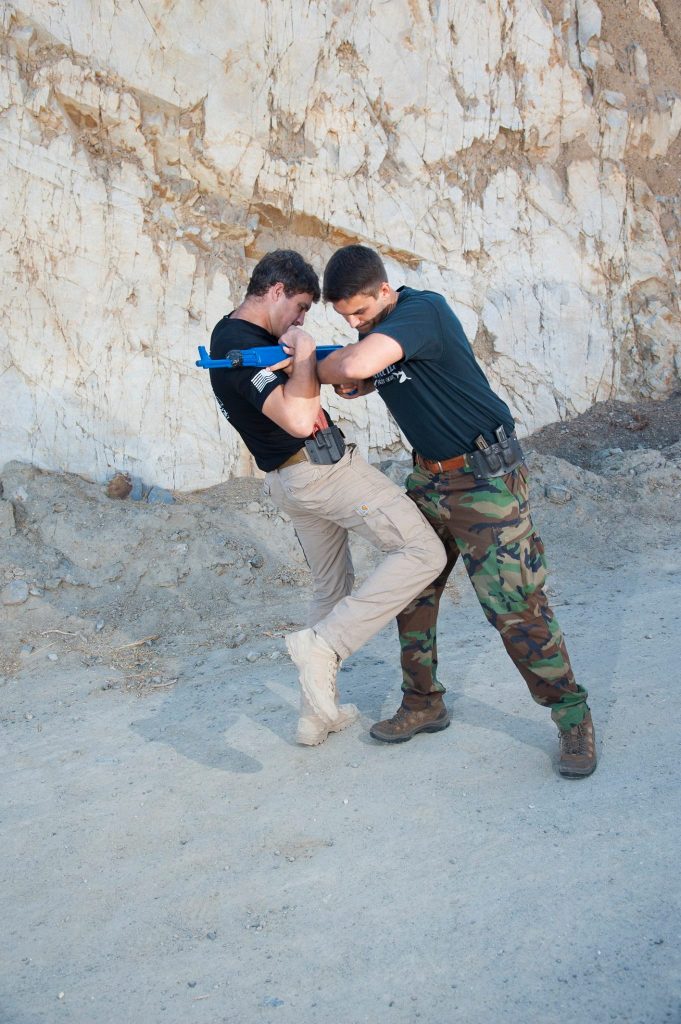Due to the prevalence of active shooter incidents in the United States we have drawn on our active shooter program and guidelines to put together some simple how-to instructions for such an incident.
What You Need to Know About Active Shooter Protocols

Special response team members practicing an active shooter situation
Identifying an Attacker
Look to see anyone who is out of place, looks nervous, or is sweating. Are they wearing inappropriately bulky clothes for the weather? If you have identified a suspicious person, look for printing of concealed weapons on their body, particularly around the waist. “See something, say something”. Inform authorities if you are suspicious. Remember trust your instinct, if this person gives you a nervous or creepy feeling, trust this instinct.
Run, Hide, Fight
If the shooting begins, run! Get out of the area, if you are unarmed and not within arm’s reach of the attacker there is nothing for you to do but survive. Hide; get behind cover, something that will stop bullets, cement barricades, an engine block of a car, solid door, etc… This hiding place will be even better if concealed from the view of the attacker. Fight; if you cannot run or your hiding place is discovered, do your best to attack and neutralize the attacker. Coordinate others in this effort, over power the attacker and use improvised weapons to do so. Chairs to bludgeon, box cutters or letter openers to slash and stab, and any other item which can be of use. If death is imminent, it is better to do something rather than nothing.
Cover vs. Concealment
Concealment obstructs the shooters view, but will not stop the penetration of bullets. Cover will stop the penetration of bullets. Cover may also conceal you, this is the best place to hide.
Call 911
Place a 911 call. Try to breathe and remain as calm as possible. Describe only pertinent information to the dispatcher; how many shooters are there, where are they located presently, what direction are they going, are they armed with pistols, long guns, or both, what are they wearing, how many casualties do you see or know about, how many rounds have they fired approximately, what is your present location. This is critical information, so do your best to convey this.
First aid for the wounded
Only treat people if it is safe to do so. Becoming a casualty helps no one and adds another problem for EMS when they arrive. If it is safe to do so, start treating the injured. Your first priority is to stop blood loss through the use of direct pressure on wounds and tourniquets on badly bleeding limbs. You can improvise both pressure bandages and tourniquets. After bleeding has been managed make sure the casualty has a patent airway by either opening the airway through a chin lift technique or rolling them to a recovery position (left side). DO NOT begin CPR on a casualty with an active bleed. Stop all bleeding first before you begin CPR.
Arrival of law enforcement
Law enforcement will NOT stop to treat you if the shooter is still active, they will move past you to engage and neutralize the threat. Help them make it easy to identify that you are not a threat. You can do this by putting your hands out, open, with fingers spread. Immediately comply with all commands from law enforcement. Do not grab or attempt to pull officers to you to assist you. EMS will not arrive on scene until it is secure, so let the officers secure the scene this is the fastest way to make sure casualties will receive aid.
Aftermath
Stay around to be debriefed by law enforcement (if you are uninjured). Find your friends if possible, and call your loved ones. If you are experiencing anxiety or other psychological effects speak to a grief counselor (usually provided by the municipality, state, or federal government) or seek treatment from a mental health professional.
Post Traumatic Stress (PTSD)
If, in the days and weeks following, you are experiencing anxiety, irritability, sudden bouts of uncontrollable fear, mood swings, trouble sleeping, nightmares, or daytime rumination on these events seek out a mental health professional. Take some time off work to do activities you enjoy, and generally make sure you are mentally healthy. These events are incredibly damaging, and you need to make sure you take care of yourself as well as those colleagues and friends who may be effected as well.
Train
Receive training from professionals. Undergo active shooter drills. Understand what an effective active shooter response looks like. Get into medical training specific to the kinds of injuries you may see. Additionally seek out some self defense training that could be effective in these types of active shooter scenarios.
Krav Maga Academy San Diego, in partnership with Active Shooter Defense School, and Global Media Risk, runs active shooter training for civilians, first responders, schools, government facilities, and private institutions. If you are concerned about your safety and would like to get professional training, in a Red Cross and FEMA certified course run by top security professionals then contact us today.

